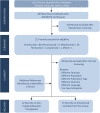Real-world efficacy of treatment with benralizumab, dupilumab, mepolizumab and reslizumab for severe asthma: A systematic review and meta-analysis
- PMID: 35174566
- PMCID: PMC9311192
- DOI: 10.1111/cea.14112
Real-world efficacy of treatment with benralizumab, dupilumab, mepolizumab and reslizumab for severe asthma: A systematic review and meta-analysis
Abstract
Background: Severe asthma is a major cause of morbidity. Some patients may benefit from biological therapies. Most evaluations of these treatments are derived from randomized controlled trials (RCTs), but few patients are eligible for these trials. Studies involving more diverse groups of participants exist, but there is a lack of precise pooled estimates.
Objective: This systematic review aims to evaluate the real-world efficacy of recently and nearly licensed biological therapies for severe asthma to assess the generalizability of the RCT data.
Methods: Clinical outcomes including exacerbation rate, oral corticosteroid usage, forced expiratory volume in 1 second (FEV1 ) and fractional exhaled nitric oxide (FeNO) were examined. Studies were assessed for risk of bias using the Critical Appraisal Skills Programme checklist tool. The certainty of evidence was assessed using Grading of Recommendations, Assessment, Development and Evaluations (GRADE).
Results: A total of 21 studies examining biologicals in real-world settings were identified; they mostly focused on benralizumab and mepolizumab. The introduction of biologicals reduced the annualzsed exacerbation rate significantly by -3.79 (95% confidence interval [CI] -4.53, -3.04), -3.17 (95% CI -3.74, -2.59) and -6.72 (95% CI -8.47, -4.97) with benralizumab, mepolizumab and reslizumab, respectively. Likewise, improvements were observed in FEV1 (0.17 L 95% CI 0.11, 0.24) and FeNO (-14.23 ppb 95% CI -19.71, -8.75) following the treatment with mepolizumab. After treatment with benralizumab, there was an increase in FEV1 (0.21 L 95% CI 0.08, 0.34).
Conclusions: These data demonstrate that anti-IL5 biologicals may improve the clinical outcomes of patients with severe asthma in a clinic environment with similar effect sizes to RCTs. The data were mainly retrospective and unadjusted, so estimated effect sizes may not be reliable. More data are needed to acquire accurate effect estimates in different subpopulations of patients.
Keywords: FEV1; FeNO; asthma; asthma control; benralizumab; dupilumab; exacerbations; mepolizumab; real-world studies; reslizumab.
© 2022 The Authors. Clinical & Experimental Allergy published by John Wiley & Sons Ltd.
Conflict of interest statement
The authors know of no conflict of interest.
Figures


References
-
- Chung KF, Wenzel SE, Brozek JL, et al. International ERS/ATS guidelines on definition, evaluation and treatment of severe asthma. Eur Respir J. 2014;43(2):343‐373. - PubMed

